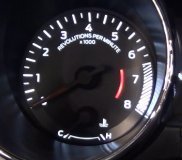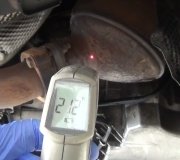DTC P1672: CAN Bus Off Failure
Fig. 152: DTC P1672: CAN Bus Off Failure - Diagnostic Wiring Diagram
Courtesy of SUZUKI OF AMERICA CORP.
Circuit Description
The transaxle control module (TCM) is an electronic device which monitors inputs to control various transaxle functions including shift quality and transaxle sensors, switches, and components to process for use within its' control program. Based on this input information, the TCM controls various transaxle output functions and devices.
Information is transmitted between the TCM and ECM through the CAN. Information is as follows:
Engine Malfunction Signal.
Engine Speed.
Engine Output Torque Reduction Signal.
Engine Coolant Temperature.
Conditions for Setting the DTC
System voltage is too high or too low.
CAN transmitting wiring harness shortage or open.
TCM or ECM is defective.
Immediately after the above condition occurs.
Action Taken When the DTC Sets
The malfunction indicator lamp (MIL) will illuminate.
The TCM will record operating conditions at the time the diagnostic fails. This information will be stored in the Failure Records buffer.
Adopt Emergency/ Substitute mode and constant 4th gear by hydraulic control.
After ignition OFF/ON: 3rd gear by hydraulic control. Possible P, R and N also possible.
Conditions for Clearing the MIL/DTC
The MIL will turn OFF when the malfunction has not occurred after three-ignition cycles.
A history DTC will clear after 40 consecutive warm up cycles without a fault.
Using a scan tool can clear history DTCs.
Fig. 153: DTC P1672: CAN Bus Off Failure Diagnostic Chart
Courtesy of SUZUKI OF AMERICA CORP.
DTC P1673: CAN Receive ECM Message Failure
Fig. 154: DTC P1673: CAN Receive ECM Message Failure - Diagnostic Wiring Diagram
Courtesy of SUZUKI OF AMERICA CORP.
Circuit Description
The transaxle control module (TCM) is an electronic device which monitors inputs to control various transaxle functions including shift quality and transaxle sensors, switches, and components to process for use within its' control program. Based on this input information, the TCM controls various transaxle output functions and devices.
Information is transmitted between the TCM and ECM through the CAN. Information is as follows:
Engine Malfunction Signal.
Engine Speed.
Engine Output Torque Reduction Signal.
Engine Coolant Temperature.
Conditions for Setting the DTC
System voltage is too high or too low.
CAN transmitting wiring harness shortage or open.
TCM or ECM is defective.
Immediately after the above condition occurs.
Action Taken When the DTC Sets
The malfunction indicator lamp (MIL) will illuminate.
The TCM will record operating conditions at the time the diagnostic fails. This information will be stored in the Failure Records buffer.
Adopt Emergency/ Substitute mode and constant 4th gear by hydraulic control.
After ignition OFF/ON: 3rd gear by hydraulic control. Possible P, R and N also possible.
Conditions for Clearing the MIL/DTC
The MIL will turn OFF when the malfunction has not occurred after three-ignition cycles.
A history DTC will clear after 40 consecutive warm up cycles without a fault.
Using a scan tool can clear history DTCs.
SPONSORED LINKS
Friday, April 30th, 2010 AT 5:28 AM



